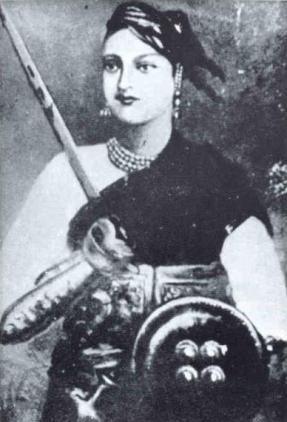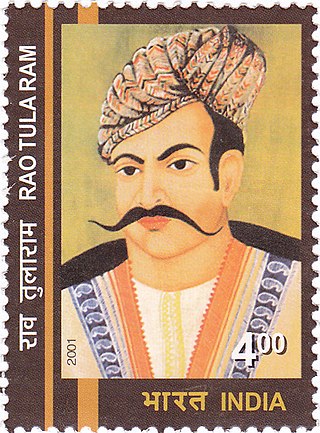| |||||
| Centuries: | |||||
|---|---|---|---|---|---|
| Decades: | |||||
| See also: | List of years in India Timeline of Indian history | ||||
Events in the year 1859 in India.
| |||||
| Centuries: | |||||
|---|---|---|---|---|---|
| Decades: | |||||
| See also: | List of years in India Timeline of Indian history | ||||
Events in the year 1859 in India.
//

Mutiny is a revolt among a group of people to oppose, change, or remove superiors or their orders. The term is commonly used for insubordination by members of the military against an officer or superior, but it can also sometimes mean any type of rebellion against any force. Mutiny does not necessarily need to refer to a military force and can describe a political, economic, or power structure in which subordinates defy superiors.

Lakshmibai Newalkar, the Rani of Jhansi, was the Maharani consort of the princely state of Jhansi in the Maratha Empire from 1843 to 1853 by marriage to Maharaja Gangadhar Rao Newalkar. She was one of the leading figures in the Indian Rebellion of 1857, who became a national hero and symbol of resistance to the British rule in India for Indian nationalists.

The Indian Rebellion of 1857 was a major uprising in India in 1857–58 against the rule of the British East India Company, which functioned as a sovereign power on behalf of the British Crown. The rebellion began on 10 May 1857 in the form of a mutiny of sepoys of the company's army in the garrison town of Meerut, 40 mi (64 km) northeast of Delhi. It then erupted into other mutinies and civilian rebellions chiefly in the upper Gangetic plain and central India, though incidents of revolt also occurred farther north and east. The rebellion posed a military threat to British power in that region, and was contained only with the rebels' defeat in Gwalior on 20 June 1858. On 1 November 1858, the British granted amnesty to all rebels not involved in murder, though they did not declare the hostilities to have formally ended until 8 July 1859.

Nana Saheb Peshwa II, born as Dhondu Pant, was an Indian aristocrat and fighter, who led the rebellion in Cawnpore (Kanpur) during the 1857 rebellion against the East India Company. As the adopted son of the exiled Maratha Peshwa Baji Rao II, Nana Saheb believed that he was entitled to a pension from the company, but as he was denied recognition under Lord Dalhousie's doctrine of lapse, he initiated a rebellion. He forced the British garrison in Kanpur to surrender, then murdered the survivors, gaining control of the city for a few days. After a British force recaptured Kanpur, Nana Saheb disappeared, with multiple conflicting accounts existing of his further life and death.
Events in the year 1857 in India.

Field Marshal Hugh Henry Rose, 1st Baron Strathnairn, was a senior British Army officer. He served as a military adviser to the Ottoman Army who were seeking to secure the expulsion of the forces of Mehemet Ali from Syria during the Egyptian–Ottoman War. He then fought with the French Army at the Battle of Alma, the Battle of Inkerman and at the Battle of Mamelon during the Crimean War. During the Indian Rebellion of 1857 Rose was given command of the Central Indian Field Force and was successful at the battle of Jhansi in April 1858, at Lahar in May 1858 and at Gwalior in June 1858. He went on to be Commander of the Bombay Army, Commander-in-Chief, India and then Commander-in-Chief, Ireland.

The siege of Cawnpore was a key episode in the Indian Rebellion of 1857. The besieged East India Company forces and civilians in Cawnpore were duped into a false assurance of a safe passage to Allahabad by the rebel forces under Nana Sahib. Their evacuation from Cawnpore thus turned into a massacre, and most of the men were killed and women and children taken to a nearby dwelling known as Bibi Ghar. As an East India Company rescue force from Allahabad approached Cawnpore, 120 British women and children captured by the rebels were butchered in what came to be known as the Bibi Ghar massacre, their remains then thrown down a nearby well. Following the recapture of Cawnpore and the discovery of the massacre, the angry Company forces engaged in widespread retaliation against captured rebel soldiers and local civilians. The murders greatly enraged the British rank-and-file against the sepoy rebels and inspired the war cry "Remember Cawnpore!".
The Second Battle of Cawnpore was a battle of Indian Rebellion of 1857 that was decisive by thwarting the rebels' last chance to regain the initiative and to recapture the cities of Cawnpore and Lucknow.
The Central India Campaign was one of the last series of actions in the Indian rebellion of 1857. The British Army and Bombay Army overcame a disunited collection of states in a single rapid campaign, although determined rebels continued a guerrilla campaign until the spring of 1859.

Rao Tularam Singh was a Yaduvanshi Ahir King or chieftain of Rewari. He was one of the leaders of the Indian rebellion of 1857 in Haryana, where he is considered a state hero.
The 3rd Bombay European Regiment was an infantry regiment raised by the British East India Company in 1853. They were created originally for the defence of Bombay (Mumbai) and were stationed initially in Pune, but they were soon called upon to quell the Indian Rebellion of 1857.
Events in the year 1858 in India. Act of Parliament 1858
Events in the year 1860 in India.
Nana Rao Park / Company Bagh is a public city park in Kanpur, the industrial hub of Uttar Pradesh, India, built after Indian independence in honor of Nana Sahib. Prior to Indian Independence the location was known as Memorial Well and commemorated the massacre of British women and children during the Indian Rebellion of 1857.
Events in the year 1830 in India.

Jhansi was an independent princely state ruled by the Maratha Newalkar dynasty under suzerainty of British India from 1804 till 1853, when the British authorities took over the state under the terms of the Doctrine of Lapse, and renamed it the Jhansi State. Before the takeover, it was under the Peshwas from 1728 to 1804. The fortified town of Jhansi served as its capital.
Bhima Nayak or Bheema Nayak was an Indian revolutionary. He fought against the British in the Indian Rebellion of 1857. When Bhima was convicted by the British government, he was kept in Port Blair and Nicobar.
Reuben Dhondji Ashtumkar was a Bene Israel soldier who fought in the Indian Rebellion of 1857.

Tantia Tope was a notable commander in the Indian Rebellion of 1857.
Ali Bahadur II (1832–1873) was the last ruler (Nawab) of Banda. He decided to join the Indian Rebellion of 1857, he joined forces of Rani of Jhansi, Rao Sahib and Tantia Tope and was one of Major Commanders of Rebel force at Gwalior and in the aftermath his state was annexed by the British Raj. He also helped tatya tope in Siege of Charkhari.He surrendered in November 1858 and lived in exile at Indore with Pension of Rs. 36,000 per annum and he died in 1873. He was a descendant of Peshwa Baji Rao I and his Muslim wife Mastani.